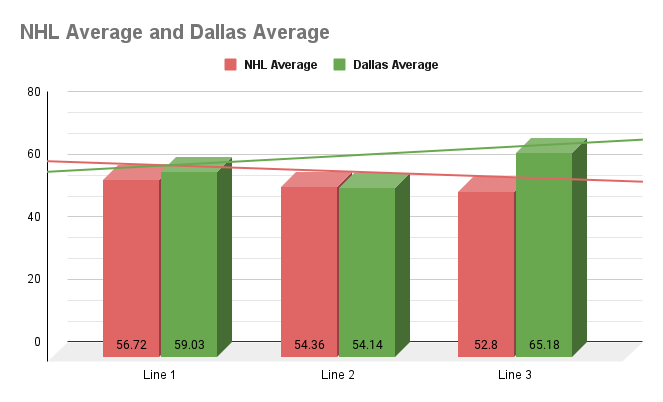It hasn’t always been clean, but the Stars are sitting pretty, and firmly atop the Central. Their grip got tighter after a dominant win over a great team in the New York Rangers on Monday, aided by an epic collapse by the Colorado Avalanche against the Nashville Predators. By points percentage, the Stars are fifth in the league, placing them in the ranks of the Who’s Who of hockey.
How are they doing it? Depth. Lots of depth.
Any discussion about Dallas’ depth chart starts with Matt Duchene, because of course it does. He’s the reason that Tyler Seguin and Mason Marchment are suddenly a thing. With Duchene next to Seguin and Marchment, the Stars control 65 percent of the on-ice expected goal share — third among all trios with at least 100 minutes together — and are outsourcing opponents 11 to 2(!). However, this isn’t just about Duchene. Wyatt Johnston is casually on pace for 30 goals and 60-plus points. Seguin is producing like a second-line center with a strong defensive impact. Jamie Benn’s resurgence has continued, Joe Pavelski continues to defy time, and Jason Robertson and Roope Hintz have been their usual selves.
Add it up, and the 2022-23 Stars are on pace to make history by being the only Dallas roster to have seven 20-goal scorers.
That’s right. Only three other Dallas rosters were loaded enough to have six 20-goal scorers. One of them starred Mike Modano (the 2002-03 squad, led statistically by Jere Lehtinen). Another was led by Loui Eriksson, in 2009-10. The third was last season, Dallas’ first under Pete DeBoer.
Branching outside of Dallas, only six teams in the cap era (2005) have generated seven or more 20-goal scorers. One of them, Colorado, won the Cup just two seasons ago, and the only team that gave them hell along the way was the St. Louis Blues, who boasted a whopping nine 20-plus goal scorers. Even if the Stars don’t reach that highwater mark tallied by St. Louis and Colorado, you’ll be reassured to know that in the last 23 years, 15 percent of the teams with at least six 20-goal scorers have reached the Stanley Cup Final, a loftier percentage than it seems in the 30-team NHL.
However, production is fickle. The right bounces can make a team look unstoppable when it should be vulnerable. So when considering Dallas’ depth in the context of Cup favorites, the more important measure is figuring out whether that depth generates offense from shift to shift rather than from goal to goal.
Because the Stars’ premier seven goal scorers are spread across three lines, I pooled every team’s expected goal share for each of its top three trios going back to 2008, trying to compare Dallas’ depth to its corresponding counterparts. I’ve given the Johnston line the honor of “Line Two” due to its total minutes together.
Broadly speaking, this is all pretty intuitive. As you progress down the forward lineup, quality possession gradually declines. Top lines do better than second lines, which do better than third lines—signed, Captain Obvious.
But this Dallas squad bucks the trend. The top line is more dominant than usual from shift to shift and the second line operates pretty much exactly like a second line, but the “third line” (starring Duchene with Seguin and Marchment) crushes everything in its path. Another way of interpreting this data is that Dallas’ depth is very, very sustainable in a way that is very different from most teams.
The Stars also stand above their peers in another category: they have a league-leading nine players on pace for 40 or more points. Winnipeg, Philadelphia, Ottawa, New Jersey, and Carolina sit behind the Stars with eight. For perspective, defending champion Vegas had seven players who scored 40 or more points last year, while Colorado had eight when it won the Cup.
Granted, players being on pace for X amount of goals and Y amount of points is not the same as delivering them when all is said and done. That’s the asterisk in all of this. Not all of those half-dozen teams will finish the year with eight or more 40-plus point scorers; for all we know, Dallas could fall short. But given the resumes, skill sets, and data, it’s difficult to envision what might slow this group outside of injuries. In fact, a case could be made that the Stars haven’t even achieved their final form, given the prospect firepower they have down in Cedar Park.
It seems obvious enough, but it’s still worth reiterating what makes Dallas’ depth so important: it sticks, whether it’s the regular season or the postseason. As The Boston Globe’s Julien Benbow noted, “Of the 39 teams with at least six 20-goal scorers since 2000, 17 received goals in the playoffs from each of those players. Nine got scores from all but one.”
So while the Stars aren’t perfect—note the absence of any blueline talk in this piece—they’re proving how little their imperfections can hold them back. It’s the lesson the spiraling Edmonton Oilers are learning the hard way despite having the best player in the world: your best players have to be your best players, but it’s harder for them to excel when opponents need only defend them, and not the rest.
The Stars don’t have this problem. Just like when teams could defend Modano but then had to worry about Joe Nieuwendyk, there are too many threats in place to keep the offense quiet for long. That’s a recipe for making a lot of noise in April and May.
Author








